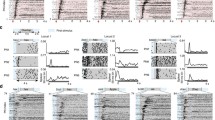Abstract
Single-unit electrophysiology was used to record the nerve impulses from the carbon dioxide receptors of female Queensland fruit flies, Bactrocera tryoni. The receptors responded to stimulation in a phasic-tonic manner and also had a period of inhibition of the nerve impulses after the end of stimulation, at high stimulus intensities. The cell responding to carbon dioxide was presented with a range of environmental odorants and found to respond to methyl butyrate and 2-butanone. The coding characteristics of the carbon dioxide cell and the ability to detect other odorants are discussed, with particular reference to the known behavior of the fly.
Similar content being viewed by others
REFERENCES
BOGNER, F. 1990. Sensory physiological investigation of carbon dioxide receptors in Lepidoptera. J. Insect Physiol. 36:951-957.
BOGNER, F. 1992. Response properties of CO2-sensitive receptors in tsetse flies (Diptera: Glossina palpalis). Physiol. Entomol. 17:19-24.
BOGNER, F., BOPPRé, M., ERNST, K. D., and BOECKH, J. 1986. CO2 sensitive receptors on labial palps of Rhodogastria moths (Lepidoptera: Arctiidae): Physiology, fine structure and central projection. J. Comp. Physiol. A 158:741-749.
DEN OTTER, C. J., and VAN DER GOES VAN NATERS, W. M. 1992. Single cell recordings from tsetse (Glossina m. morsitans) antennae reveal olfactory, mechano-and cold receptors. Physiol. Entomol. 17:33-42.
DICKENS, J. C. 1984. Olfaction in the boll weevil, Anthonomus grandis Boh. (Coleoptera: Curculionidae): electroantennogram studies. J. Chem. Ecol. 10:1759-1785.
DICKENS, J. C., HART, W. G., LIGHT, D. M., and JANG, E. B. 1988. Tephritid olfaction: Morphology of the antennae of four tropical species of economic importance (Diptera: Tephritidae). Ann. Entomol. Soc. Am. 81:325-331.
EISEMANN, C. H., and RICE, M. J. 1992. Attractants for the gravid Queensland fruit fly Dacus tryoni. Entomol. Exp. Appl. 62:125-130.
GIANNAKAKIS, A., and FLETCHER, B. S. 1985. Morphology and distribution of antennal sensilla of Dacus tryoni (Froggatt) (Diptera: Tephritidae). J. Aust. Entomol. Soc. 24:31-35.
GRANT, A. J., WIGTON, B. E., AGHAJANIAN, J. G., and O'CONNELL, R. J. 1995. Electrophysiological responses of receptor neurons in mosquito maxillary palp sensilla to carbon dioxide. J. Comp. Physiol. A 177:389-396.
HEINBOCKEL, T., and KAISSLING, K.-E. 1996. Variability of olfactory receptor neuron responses of female silkmoths (Bombyx mori L.) to benzoic acid and (±)-linalool. J. Insect Physiol. 42:565-578.
HULL, C. D., and CRIBB, B. W. 1997. Ultrastructure of the antennal sensilla of Queensland fruit fly, Bactrocera tryoni (Froggatt) (Diptera: Tephritidae). Int. J. Insect Morphol. Embryol. 26:27-34.
HULL, C. D., and CRIBB, B. W. 2001. Olfaction in the Queensland fruit fly, Bactrocera tryoni I. Identification of olfactory receptor neuron types responding to environmental odours. J. Chem. Ecol. 27:871-887.
KAISSLING, K.-E. 1986. Temporal characteristics of pheromone receptor cell responses in relation to orientation behaviour of moths, pp. 193-199, in T. L. Payne, M.C. Birch and C. E. J. Kennedy (eds.). Mechanisms in Insect Olfaction. Clarendon Press, Oxford.
KELLOGG, F. E. 1970. Water vapour and carbon dioxide receptors in Aedes aegypti (L.). J. Insect Physiol. 16:99-108.
O'CONNELL, R. J. 1986. Electrophysiological responses to pheromone blends in single olfactory receptor neurones, pp. 217-224, in T. L. Payne, M. C. Birch, and C. E. J. Kennedy (eds.). Mechanisms in Insect Olfaction. Clarendon Press, Oxford.
PAYNE, T. L., and DICKENS, J. C. 1976. Adaptation to determine receptor system specificity in insect olfactory communication. J. Insect Physiol. 22:1569-1572.
RASCH, C., and REMBOLD, H. 1994. Carbon-dioxide-highly attractive signal for larvae of Helicoverpa armigera. Naturwissenshaften 81:228-229.
RICE, M. J. 1989. The sensory physiology of pest fruit flies: conspectus and prospectus, pp. 249-272, in A. S. Robinson and G. H. S. Hooper (eds.). Fruit Flies-Their Biology, Natural Enemies and Control. World Crop Pests 3(A). Elsevier, Amsterdam.
RUMBO, E. R., and KAISSLING, K.-E. 1989. Temporal resolution of odour pulses by three types of pheromone receptor cells in Antheraea polyphemus. J. Comp. Physiol. A 165:281-291.
SCHNEIDER, D., KAFKA, W. A., BEROZA, M., and BIERL, B. A. 1977. Odor receptor responses of male gypsy and nun moth (Lepidoptera, Lymantriidae) to disparlure and its analogues. J. Comp. Physiol. A 113:1-15.
STANGE, G. 1975. Linear relation between stimulus concentration and primary transduction process in insect CO2-receptors, pp. 207-211, in D. A. Denton and J. P. Coghlan (eds.). Olfaction and Taste V. Academic Press, New York.
STANGE, G. 1992. High resolution measurement of atmospheric carbon dioxide concentration changes by the labial palp organ of the moth Heliothis armigera (Lepidoptera: Noctuidae). J. Comp. Physiol. A 171:317-324.
STANGE, G. 1996. Sensory and behavioural responses of terrestrial invertebrates to biogenic carbon dioxide gradients, pp. 223-253, in G. Stanhill (ed.). Advances in Bioclimatology 4. Springer-Verlag, Berlin.
STANGE, G. 1997. Effects of changes in atmospheric carbon dioxide on the location of hosts by the moth, Cactoblastis cactorum. Oecologia 110:533-539.
STANGE, G. 1999. Carbon dioxide is a close-range oviposition attractant in the Queensland fruit fly Bactrocera tryoni. Naturwissenschaften 86:190-192.
STANGE, G., and KAISSLING, K.-E. 1995. The site of action of general anaesthetics in insect olfactory receptor neurons. Chem. Senses 20:421-432.
STANGE, G., and WONG, C. 1993. Moth response to climate. Nature 365:699.
STANGE, G., MONRO, J., STOWE, S., and OSMOND, C. B. 1995. The CO2 sense of the moth Cactoblastis cactorum and its probable role in the biological control of the CAM plant Opuntia stricta. Oecologia 102:341-352.
SUTCLIFFE, J. F. 1994. Sensory bases of attractancy: morphology of mosquito olfactory sensilla-a review. J. Am. Mosq. Control Assoc. 10:309-315.
YAMANA, K., TOH, Y., and TATEDA, H. 1986. Electrophysiological studies on the temporal organ of the Japanese house centipede, Thereuonema hilgendorfii. J. Exp. Biol. 126:297-314.
ZACHARUK, R. Y. 1985. Antennae and sensilla, pp. 1-69, in G. A. Kerkut and L. I. Gilbert (eds.). Comprehensive Insect Physiology, Biochemistry and Pharmacology, Volume 6. Pergamon Press, London.
ZIESMANN, J. 1996. The physiology of an olfactory sensillum of the termite Schedorhinotermes lamanianus: Carbon dioxide as a modulator of olfactory sensitivity. J. Comp. Physiol. A 179:123-133.
Author information
Authors and Affiliations
Rights and permissions
About this article
Cite this article
Hull, C.D., Cribb, B.W. Olfaction in the Queensland Fruit Fly, Bactrocera tryoni. II: Response Spectra and Temporal Encoding Characteristics of the Carbon Dioxide Receptors. J Chem Ecol 27, 889–906 (2001). https://doi.org/10.1023/A:1010326801480
Issue Date:
DOI: https://doi.org/10.1023/A:1010326801480




